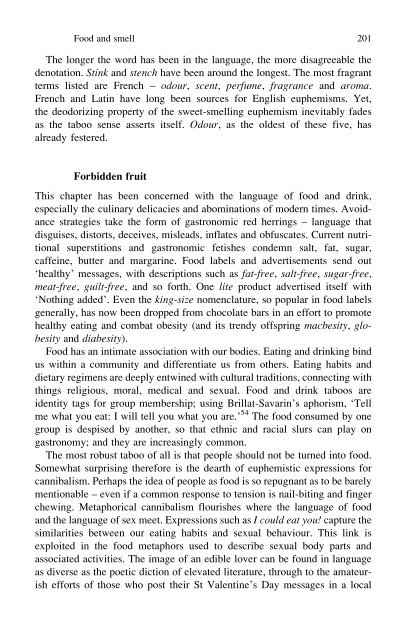Forbidden Words: Taboo and the Censoring of Language
Forbidden Words: Taboo and the Censoring of Language
Forbidden Words: Taboo and the Censoring of Language
You also want an ePaper? Increase the reach of your titles
YUMPU automatically turns print PDFs into web optimized ePapers that Google loves.
Food <strong>and</strong> smell 201<br />
The longer <strong>the</strong> word has been in <strong>the</strong> language, <strong>the</strong> more disagreeable <strong>the</strong><br />
denotation. Stink <strong>and</strong> stench have been around <strong>the</strong> longest. The most fragrant<br />
terms listed are French – odour, scent, perfume, fragrance <strong>and</strong> aroma.<br />
French <strong>and</strong> Latin have long been sources for English euphemisms. Yet,<br />
<strong>the</strong> deodorizing property <strong>of</strong> <strong>the</strong> sweet-smelling euphemism inevitably fades<br />
as <strong>the</strong> taboo sense asserts itself. Odour, as <strong>the</strong> oldest <strong>of</strong> <strong>the</strong>se five, has<br />
already festered.<br />
<strong>Forbidden</strong> fruit<br />
This chapter has been concerned with <strong>the</strong> language <strong>of</strong> food <strong>and</strong> drink,<br />
especially <strong>the</strong> culinary delicacies <strong>and</strong> abominations <strong>of</strong> modern times. Avoidance<br />
strategies take <strong>the</strong> form <strong>of</strong> gastronomic red herrings – language that<br />
disguises, distorts, deceives, misleads, inflates <strong>and</strong> obfuscates. Current nutritional<br />
superstitions <strong>and</strong> gastronomic fetishes condemn salt, fat, sugar,<br />
caffeine, butter <strong>and</strong> margarine. Food labels <strong>and</strong> advertisements send out<br />
‘healthy’ messages, with descriptions such as fat-free, salt-free, sugar-free,<br />
meat-free, guilt-free, <strong>and</strong> so forth. One lite product advertised itself with<br />
‘Nothing added’. Even <strong>the</strong> king-size nomenclature, so popular in food labels<br />
generally, has now been dropped from chocolate bars in an effort to promote<br />
healthy eating <strong>and</strong> combat obesity (<strong>and</strong> its trendy <strong>of</strong>fspring macbesity, globesity<br />
<strong>and</strong> diabesity).<br />
Food has an intimate association with our bodies. Eating <strong>and</strong> drinking bind<br />
us within a community <strong>and</strong> differentiate us from o<strong>the</strong>rs. Eating habits <strong>and</strong><br />
dietary regimens are deeply entwined with cultural traditions, connecting with<br />
things religious, moral, medical <strong>and</strong> sexual. Food <strong>and</strong> drink taboos are<br />
identity tags for group membership; using Brillat-Savarin’s aphorism, ‘Tell<br />
me what you eat: I will tell you what you are.’ 54 The food consumed by one<br />
group is despised by ano<strong>the</strong>r, so that ethnic <strong>and</strong> racial slurs can play on<br />
gastronomy; <strong>and</strong> <strong>the</strong>y are increasingly common.<br />
The most robust taboo <strong>of</strong> all is that people should not be turned into food.<br />
Somewhat surprising <strong>the</strong>refore is <strong>the</strong> dearth <strong>of</strong> euphemistic expressions for<br />
cannibalism. Perhaps <strong>the</strong> idea <strong>of</strong> people as food is so repugnant as to be barely<br />
mentionable – even if a common response to tension is nail-biting <strong>and</strong> finger<br />
chewing. Metaphorical cannibalism flourishes where <strong>the</strong> language <strong>of</strong> food<br />
<strong>and</strong> <strong>the</strong> language <strong>of</strong> sex meet. Expressions such as I could eat you! capture <strong>the</strong><br />
similarities between our eating habits <strong>and</strong> sexual behaviour. This link is<br />
exploited in <strong>the</strong> food metaphors used to describe sexual body parts <strong>and</strong><br />
associated activities. The image <strong>of</strong> an edible lover can be found in language<br />
as diverse as <strong>the</strong> poetic diction <strong>of</strong> elevated literature, through to <strong>the</strong> amateurish<br />
efforts <strong>of</strong> those who post <strong>the</strong>ir St Valentine’s Day messages in a local

















